Cinema room design
Lighting, accessories, decor and ideas
What you'll read about in this article:
With such a wide variety of streaming services and platforms available at our fingertips, conventional cinemas are slowly becoming a thing of the past. Instead, movie buffs around the world try to enhance their watching experience, browsing through the web to find some home cinema room ideas for inspiration.
Some even say the rise of Netflix (and others) will be the downfall of movie theatres. Will the streaming platforms completely beat and push them out? Maybe. One thing, however, is absolutely certain.
Nothing beats a true cinema experience.
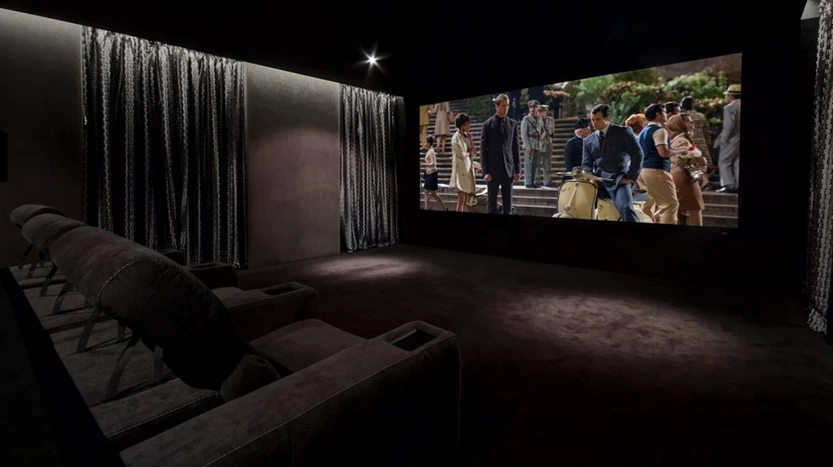
How to turn your room into cinema experience?
If you wonder how to turn your room into a cinema, the answer is actually fairly easy – you need a good sound system, a high-resolution TV or a projector, comfortable seating and quality lighting, preferably dimmable and fully adjustable. Anything else is pretty much optional. That sounds simple – and it is, but picking out the right set-up is anything but. That depends on the layout of your room you wish to turn into a home theatre and, of course, the budget.
All the options and modern solutions, we have at our disposal open up a lot of new territories to explore; we can now get the best of both worlds – the unmatched viewing experience of a cinema and the convenience of having it at home. In this article, we’ll give you some home cinema room ideas, cinema room décor pointers and discuss the most important aspects that go into building one.
A perfect home cinema is one that fits our budget and our needs. That’s why the formula is never the same. Every project is different and requires an individual approach and tailored solution. With that being said, there are some key areas we need to consider to build a quality home cinema – doesn’t matter if we’re looking for a full-blown entertainment centre, a multi-purpose room or a conventional home cinema.
We decided to put together a list of four pillars of planning out the ultimate cinema room experience:
- Audio & visuals
- Lighting
- Acoustics
- Seating
Audio & Visuals

It goes without saying that these two are the heart and soul of our project. Whether we’re building a dedicated luxury cinema room or a simple home theatre in the kitchen – high-quality image and sound are the bare minimum.
Let’s start with the heart – the visuals.
Best Visuals – a TV or a Projector?
Let’s start with the heart – the visuals. Even for the most basic setup, a large, high-resolution screen is an absolute necessity. Currently, we’re looking at the two most popular options here – a TV or a projector.
TVs
When it comes to pure quality and resolution, TVs still remain undefeated with two main technologies competing for the top spot: QLED and OLED.
The flatscreen QLED TV, which stands for Quantum Light-Emitting Diode, is actually very similar to regular LED, but it uses semiconductor nanoparticles, known as quantum dots, which convert white light into coloured light. QLEDs are able to produce a full spectrum of high-quality saturated, bright colours thanks to the precision of the employed quantum-dot LED technology. Great, rich colours and brightness is where it shines; blackness and contrast – where it doesn’t.
How does OLED TV work?
Unlike QLED, this one uses a self-emissive display, meaning that every single pixel is responsible for producing its own light. This is why it can simply turn off any lights, instead of ’emitting’ blackness. As a result, it can get as dark as when the TV is off, which creates unbelievable contrast. Great response time, paired up with superior viewing angles and still high-quality colours make it a preferred choice for, e.g., gaming. It also consumes less power, and it’s less taxing on the eyes.
Projectors
There’s only one rule in the case of cinemas – the bigger, the better and this is probably why front projectors are becoming an increasingly popular option for home theatres. In a lot of cases, it’s much more affordable, and on top of that, it’s fully customisable, portable, compact, and easier on the eyes. Projectors reflect the light from projector screens rather than produce it themselves. They are no longer these clanky, poor-quality devices we often associate them with – those days are long gone. Even though TVs are still reigning over projectors in terms of resolution and quality, projectors are not that far behind, they’re still an option worth considering. There are quite a few interesting options here, like a drop-down projector mounted in the ceiling for luxury cinema rooms, or UST (Ultra Short Throw) laser projectors that can transform a regular living room into a luxury home cinema in a matter of seconds.
We do, however, need to bear in mind that, for all its advantages, a projector is typically a whole project, not a one-off purchase – even if it tends to be a more affordable alternative to a high-end TV. To truly shine, they usually need specific dimming and lighting conditions.
Must-have accessories - do you need a projector screen?
So the question remains – do you need a projector screen? In short – yes. Simply using a wall or a sheet will never even come close to having a projector screen, at least in terms of the viewing experience – colour depth is just not the same. On top of that, they do add more freedom and portability to this already fairly customisable option.
There are floor-rising electric and drop-down screens. With more modest options or dual-use living rooms, both can work pretty well, especially paired up with smart blinds and dimming switches. The size of a TV affects its price, and for a projector – that’s simply not the case.
Our needs, expectations and budget determine our decisions. If it’s a dedicated home cinema room we aim for, the projector might a better option to achieve that authentic cinema feel. It might also be better for multi-purpose rooms thanks to the drop-down screens and compact size. Nevertheless, for the best viewing experience, we’d need to dig a little deeper into our pockets, since the larger the screen, the worse the quality when it comes to more affordable projectors. If we’d rather have a high-resolution display, and quality is what we value the most, without knocking down any walls, then a TV might a more suitable choice. Arguments can be easily made in favour of either option.
In the end, it only makes sense, if it makes sense for you.
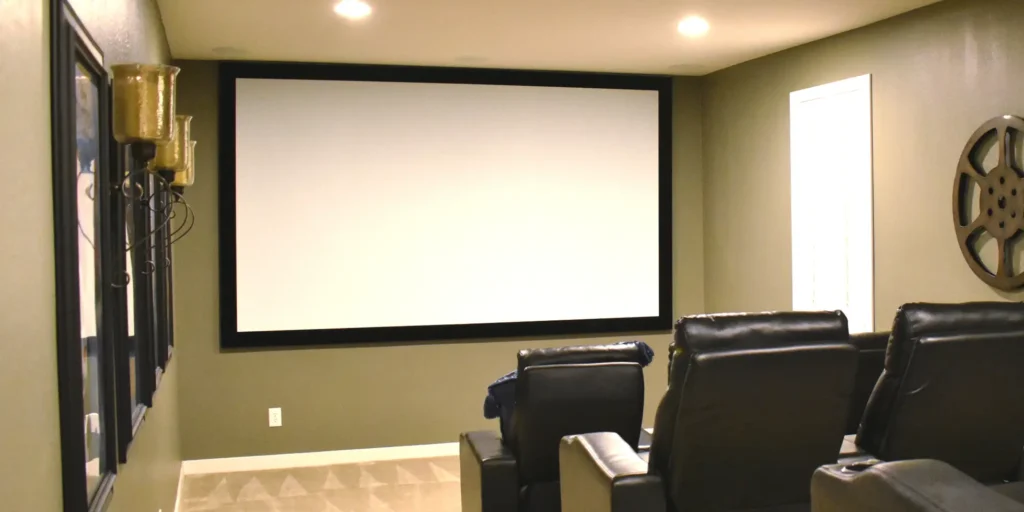
Audio
Now – the soul.
Even the best screen in the world cannot make up for a poor-quality sound system. If you’ve ever wondered what makes the cinema experience so much better than simply watching a movie at home – the answer is rather straightforward: it’s the immersive sound system, also known as the surround sound system. The sounds are coming at us from different directions, making it feel as if we were a part of the movie. When it comes to home cinemas, the quality of the sound system is just as important as the proper placement.
5.1 systems and 7.1 systems
The most frequently used systems are 5.1, which consists of five smaller speakers and a subwoofer for an added base, or 7.1 (obviously, with two additional speakers). They typically also require an AV receiver or a soundbar. Both amplify sounds, but AV receivers offer more customisation freedom and features, whereas soundbars typically are more compact and have a sleek design, very often with built-in speakers.
Speakers:
- In-ceiling speakers
- In-walls speakers
- Wireless smart speakers
- Furniture with built-in speakers
Remember that whatever you decide to go for, ideally, all of the speakers in your surround system should be identical.
Which one is the best option?
Generally speaking – the one with more speakers. It makes for a much more immersive experience, providing richer sounds, but it does take up more space. Built-in speakers are now in demand, especially for a dedicated home cinema room. They can be mounted on the ceiling or in the walls, sometimes even in custom-made furniture, to help us save more space and improve the overall aesthetics – they often have a stunning design. Although in-ceiling speakers were originally intended for music listeners, with some improvements (like drivers mounted at an angle) they work really well for Dolby Atmos systems – the ones typically used in large cinemas and movie theatres. There are also smart soundbars with wireless controls for the smart solution enthusiasts out there.
Lighting
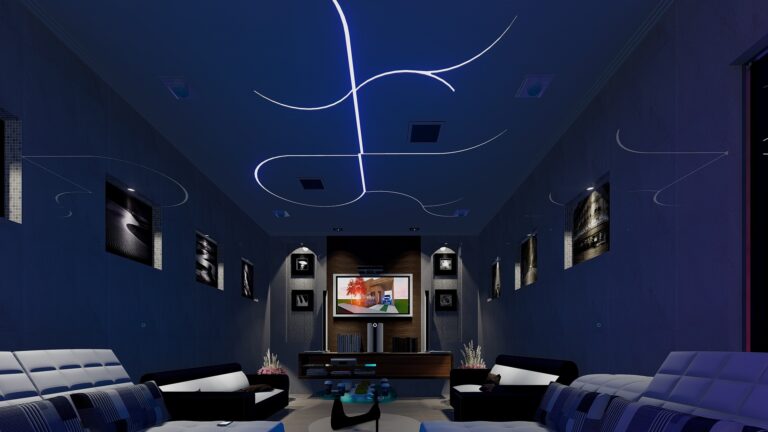
Most of the elements we’ve discussed so far were all about functionality and performance. Of course, there are different design choices, but all of them serve a very specific purpose.
With home cinema lighting, things are a little different. We have a wide variety of products and cinema room accessories available, so they can be personalized to complement any style.
Of course, lighting is just as important as the other parts. Contrary to popular belief, the room shouldn’t be completely dark – it needs some well-placed dimmed lights of the correct intensity.
Minimalist design is still the number one choice among home cinema owners, so having too many might be overkill. Keep it simple and clean, and you’ll have real-life cinema lights in the comfort of your own home.
Some of the most popular choices at the moment include:
Starlight ceiling
This is one of the hottest commodities thanks to the unique modern design and atmosphere it brings to the room. Typically used in more high-end, blacked-out home cinema rooms. Perfect for mood lighting with fully adjustable features like light transitions, cycles and brightness. Available in two technologies – LED ceiling and fibre-optic panels.
Cove lighting
It’s a fairly simple solution but offers great aesthetics – just a dimmable LED strip around the edges of the cove. It’s affordable and gives the room the illusion of height.
Staircase lighting
A true cinema staple, we can now also use it at home. With endless colour options, they bring safety to our cinema rooms and complement any design perfectly.
LED downlights
Overhead lights mounted in the ceiling are a more affordable choice. A fantastic option for a multi-purpose room where slightly better lighting is important.
LED strips
They offer an interesting design, bring freshness to any room and can be easily programmed to switch between the cycles, intensity or colours.
Wall cones
Not all high-tech solutions fit every aesthetic or, quite simply, the look we’re going for. A more traditional space, or a dual-use living room, would benefit much more from this simple and well-known solution. They’re great for everyday use and make a nice set of home cinema wall lights.
All of the above lighting systems can be integrated with Micarta’s offer consisting of wireless smart home automation lighting and shading solutions, thanks to which the users have full control over the lighting while enjoying their favourite movies and shows. Aside from home lighting automation, Micarta offers various smart home solutions for shading and ambient temperature.
Read more about this in our Complete Guide to Cinema Room Lighting article.
Acoustics
Ideally, we would build a dedicated rectangular-shaped room, and plan out the ideal layout for our speakers, seating, screen, lights, but let’s be realistic – not many of us would be willing to do that. We can focus on a question that can actually be addressed instead.
How to make sure all that hard work that went into the painstaking process of choosing a perfect audio and visual systems isn’t all in vain?
With proper acoustics.
Now, a lot of different things go into this undertaking, a big part of it is just a matter of positioning your speakers and subwoofers the right way. As for the rest – we are lucky to have a lot of accessories coming to our aid.
Acoustic panels
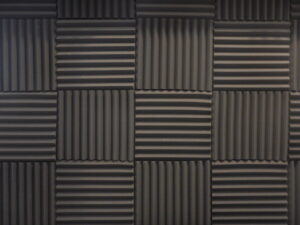
Also known as absorption panels, which are essentially sponges for sound waves, typically made from wood or foam. They help to dampen the sounds and minimise extra echoes. We don’t want to go overboard with these in our home cinema room as we’re running the risk of muffling the sound completely; it shouldn’t exceed about 15% of the total wall and ceiling surface area. There are plenty of interesting designs available, from modern to more traditional ones, but generally speaking – it’s best to go for darker, matt colours for better contrast.
Bass traps
They do exactly the same thing as acoustic panels, but unlike them, bass traps are for muffling low-frequency sounds (like thunder or animals growling), and they are typically made from fibreglass, rock wool, and foam.
Diffusers
The main role of diffusers is to make a small room sound larger than it actually is. Unlike bass traps, they are an alternative to acoustic panels. Technically they do the same thing but go about it in a different manner. Sound diffusers don’t absorb sound they spread equally across the whole room so that it’s more pleasing and natural. They’re often appreciated for their stunning design and the use of natural materials – wood. If you’re looking for a little brighter, more social entertainment centre, diffusers might the most fitting piece of the cinema room décor.
All of them can be placed on front and rear walls, sidewalls and ceiling for the best effect. It’s important to pick the ones that complement each other.
Seating (…and more)
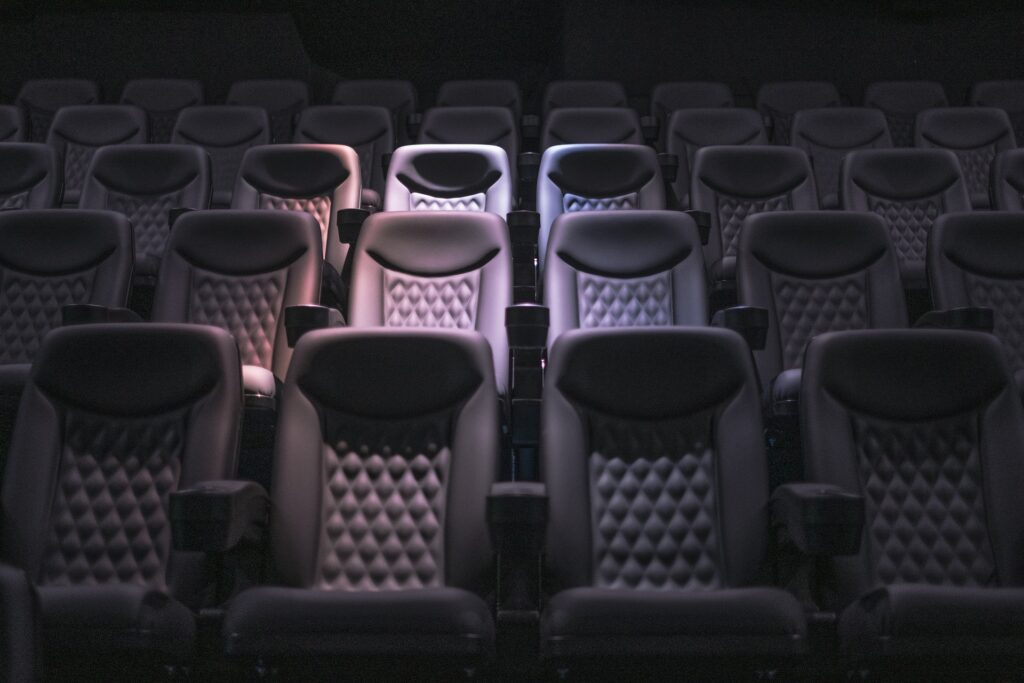
No home cinema system can be complete without a proper seating option. Functionality, in this case, is just as important as design – and there are plenty of options for everyone here. That rings particularly true for companies that offer custom-made furniture for home cinemas.
Leather upholstery
We all know and appreciate the amazing qualities of natural leather. It’s a highly sought-after luxury item, after all. Leather cinema recliners or sofas provide a perfect finishing touch for our home cinema setup. They’re stylish, durable and add a certain dose of sophistication. Some manufacturers even offer customisation options like quilting, piping, embroidery or retro trim tracks, to name a few.
Storage
When choosing a recliner for our home cinema, we should be practical and get one with trays and cupholders for snacks and drinks. Plenty of different options here – both in terms of materials and shapes. It’s a good idea to get LED-lit cupholders for practical and aesthetic reasons.
Upgrades
Anyone who enjoys different types of fancy home cinema accessories and extra features might want to look into seats with LED underglow or ambient lighting and USB ports. Some popular, more expensive models come with a powered recline, headrest and lumbar features or massage. For an improved watching experience, some seating options are equipped with transducers, which make the chair shake based on the effects and sounds in the movie.
Movable chairs and sofas
This great alternative, mostly for multi-purpose rooms, has been getting more recognition over the last few years. Perhaps slightly less impressive than the other options on the list, but nevertheless highly functional, portable and convenient.
Sofas with built-in speakers
Another strong competitor for a spot in a multi-purpose room. With their modern design and versatility, they can easily fit in any space. They’re great for enjoying some music too, not just watching movies.
Cinema beds
Although by no means is it a popular option, some cinemas indeed decided to use actual beds. Perhaps it’s not everybody’s cup of tea in a public cinema, but having one at home is a different story. Nevertheless, there are far fewer options available on the market simply because they are not nearly quite as popular as recliners or sofas. There is, however, one particularly interesting item in this category – a smart home cinema bed, with all the automation features you can think of. The main issue here is the price. Let’s just say they’re not the most affordable choice.
... and more
For anyone interested in some popular cinema room ideas – sliding walls or hidden entrances to the cinema rooms are among the hottest trends at the moment. That solution gives us the ability to quickly turn a regular living room into a real home cinema.
We hope this overview has shed some light on the current solutions, trends and design options, and that it can help you find some inspiration for your dream home cinema. The last piece of advice we have is that even though, it’s good to have some ideas and knowledge, it’s never wrong to turn to an expert. Micarta has a dedicated team with years of experience in building home cinema rooms, smart home installation and automation solutions, who will be more than happy to assist you.
Contact us
The Micarta Team are based in Kent, England. We are specialists in professional integrated technologies and provide the highest quality design, installation and service to our customers.
020 3026 9931 | info@micarta.co.uk | Kent, England, United Kingdom | Monday – Friday 0800 – 1800
